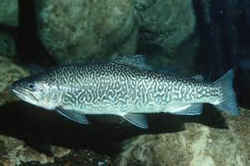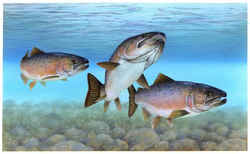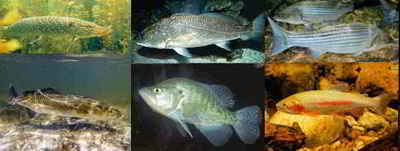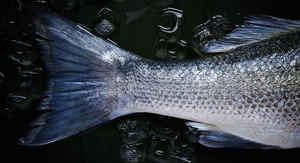Alaska State Fish
King or Chinook Salmon

(Oncorhynchus tshawytscha)
Adopted in 1962.
The giant king salmon, (Oncorhynchus tshawytscha,) is the state fish of Alaska (also called Chinook salmon, spring salmon, quinnat, tyee, tule, and blackmouth salmon) and is a popular sport fish. It became Alaska's state fish in 1962. The king salmon is native to the Pacific coast of North America. King salmon weighing up to 100 lb. have been caught in Alaska. The name chinook, is derived from the tribal name of the Indians that once lived along the Columbia River.
Alaska State Fish: King or Chinook Salmon

In California and Alaskan fisheries the species is commonly referred to as the king salmon. Springer or spring salmon is often applied to the chinook race which ascends rivers in early to late spring. Males are termed bucks; females, does or hens; 1 year old sexually mature males are called jacks.
The scientific name Oncorhynchus means hooked snout; tshawytscha is the name given to these fish by the people of the Kamchatka Peninsula, Russia.
Chinook salmon belong to the family Salmonidae and are one of eight species of Pacific salmonids in the genus Oncorhynchus. The chinook is by far the largest of the five species of Pacific salmon, with recorded weights to over 100 pounds. Average sizes vary geographically, and from river to river. Average weights for California, Oregon, and Washington fish are from between 18-22 pounds. Northern chinook races average larger sizes with the heaviest specimens coming from Alaskan waters where 50 or 60 pounders are not uncommon among sport fishermen's catches.
The adult chinook is a handsome, robust looking fish with many small black spots or blotches sprinkled along the gun-metal blue back and fins. The tail fin or caudal fin is spotted from top to bottom, which differentiates it from the coho, which is only spotted on the upper half of the tail. It also has a black gum and mouth lining; coho internal mouth linings are gray or white. Spawning adults lose their silvery bright coloration or take on a maroon or olive brown coloration, with males looking darker than females. Spawning males will also develop a hooked snout and slightly humped shoulder which is absent in spawning females. The closer the fish are to actual spawning, the darker their coloration becomes. Post spawners will usually carry large whitish looking patches which are fungus growths that attack and grow rapidly on the fishes' deteriorating flesh.
While chinook salmon have been successfully transplanted to the Great Lakes and New Zealand, the species is native in North America only to waters draining into the Pacific Ocean from central California to Point Hope, Alaska. Southernmost runs once existed as far south as San Diego, California; however, the southern extremes are now the Sacramento-San Joequin systems. Many of Oregon and Washington's coastal streams carry runs of fall or spring chinook, sometimes both. Oregon's heaviest producers are the Rogue, Umpqua, and Columbia rivers.
Entrance to rivers may vary from January through late fall, depending on the race, the river level, and the temperature. Some chinook will be entering some Pacific Coast river in every month of the year. Along with race, age is an important factor among returning adults; in any run the ages may vary from 2 years to 7 years among fully mature fish. Spawning runs may be as long as 2,000 miles, such as occurs in the Yukon River, Alaska, and 1,000 miles up the Columbia and its tributaries. Usually only the larger coastal rivers carry chinook runs, but very small tributaries off these larger rivers will host spawning chinooks as well. It is believed that chinook salmon can find the same rivers or streams they were born in, after thousands of miles of ocean travel, through olfactory and visual clues, as well as an awareness of length of days, light intensities, and ocean relationships too subtle to define.
Upon reaching their spawning grounds - typical sites are over coarse gravel, roughly golf ball to softball size - the females begin scooping out gravel depressions called redds by frantically sweeping sideways the tail and body. After the first redd is dug about 18 inches, the female will begin depositing her bright red eggs while the male emits jets of milt which mix with the eggs as the drop to the nest bottom and adhere. The female then covers the eggs with gravel. Several more redds may be excavated until the female has emptied her spawn skeins of anywhere from 2,000 to 14,000 eggs, depending on her size. Both the male and female, now totally exhausted, only have from a few hours to several days left before they are swept away in the current and die. As the carcasses decompose at the bottoms of deep pools or are caught up in debris jams important nutrients such as carbon and nitrogen are reused by the stream system.
Upon hatching, the baby salmon, called alevins, will live in the gravel for 2 to 3 weeks, absorbing their yolk sacs for sustenance. After emerging from the gravel they begin to feed immediately and opportunistically on a variety of organisms such as decaying salmon carcasses, aquatic insects, and other invertebrates. Depending on the river system the free swimming fry will remain in the river and/or estuary for up to 18 months before heading out to the ocean during their smolt stage.
While most chinook runs have declined, in many cases dramatically, they are faring better than any of the four other Pacific salmon in the continental US The chinook are highly sought after by commercial fisherman because of their large size and the high oil content of the flesh, which is bright red and rich tasting. Among sport fisherman they are regarded as the premier sport salmon. Over harvesting of the chinook is a constant danger requiring close monitoring by federal and state fishery agencies.
Characteristics of the Chinook Salmon
Color & Anatomy (Pollard et al.):
- Anal fin is not sickle-shaped: leading edge of anal fin is shorter than length of base.
- Anal fin leading edge is white.
- Adipose fin has clear center or "window."
- Dorsal fin has dark leading edge and white tip.
- Species has 16-18 branchiostegols.
- Species usually has 135-185 pyloric caeca.
Distribution:
- Chinook are usually found in moderate to large streams.
- Main channel is used for rearing.
- In large streams, 8-10 cm fish live in faster, deeper water than coho.
- Chinook may rear in estuaries of larger rivers.
Freshwater residence time:
- Chinook may form races with some rearing » 1 year, some 90 days or less depending on type. Southern populations frequently stay 90 days and northern populations are more likely to stay up to a year, but can be variable in all areas.
Chinook vs. coho:
- Chinook have "clear window" in adipose.
- Chinook do not have sickle-shaped anal fins or white and black stripes on leading edges of anal and dorsal fins.
- Coho have sickle-shaped anal fins, with leading edges longer than length of base of anal fins. Leading edges of anal and dorsal fins have white and black stripes.
- Chinook frequent main stems of moderate to large rivers. Coho are found in all accessible stream reaches, including seasonally wetted areas.
Alaska Law
The law designating the king salmon as the official Alaska state fish is Section 44.09.080 (State fish) of the 2004 Alaska Statutes, specifically Title 44 (State Government), Chapter 09 (State Seal, Flag, and Emblems), Section 060 (State fish).
Title 44. STATE GOVERNMENT.
Chapter 44.09. STATE SEAL, FLAG, AND EMBLEMS.
Sec. 44.09.080. State fish.
The king salmon (Oncorhynchus tshawytscha) is the official fish of the state.
Taxonomic Hierarchy: King or Chinook Salmon
Kingdom: Animalia - animals
Phylum: Chordata - chordates
Subphylum: Vertebrata - vertebrates
Class: Actinopterygii (ray-finned fishes)
Order: Salmoniformes
Family: (Salmonids)
Subfamily: Salmoninae
Genus: Oncorhynchus
Species: Oncorhynchus tshawytscha - Chinook salmon








